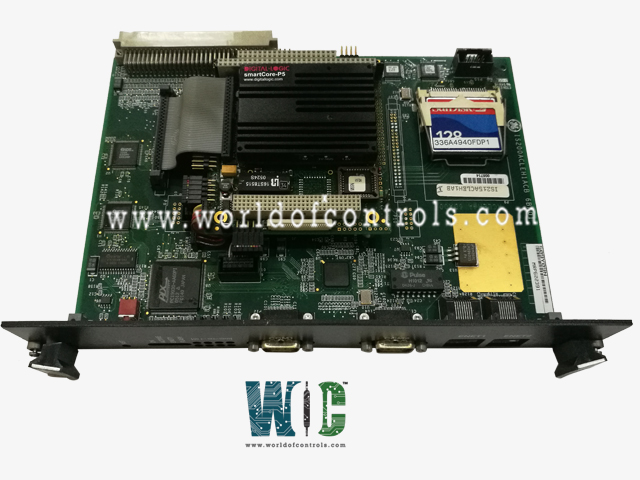SPECIFICATIONS
Part No.: IS215ACLEH1AB
Manufacturer: General Electric
Country of Manufacture: United States of America (USA)
PCB Coating: Conformal
Technology: Surface-mount
Temperature Operating: -30 to 65oC
Product Type: Application Control Layer Module
Availability: In Stock
Series: EX2100
Functional Description
IS215ACLEH1AB is a Application Control Layer Module developed by GE. It is a part of EX2100 control system. ACL represents a sophisticated microprocessor-based master controller designed to perform a multitude of functions across communication networks such as EthernetTM and ISBus. This section provides an overview of its capabilities and deployment.
Features
- Deployment in Standard Innovation Series Drive or EX2100 Exciter Board Rack: The ACL is seamlessly integrated into standard Innovation Series drive or EX2100 exciter board racks, occupying two half-slots within the rack. This subsection details its placement and utilization within these industrial setups.
- Location in Control Cabinet: In typical industrial setups, the ACL and the board rack are housed within the control cabinet. This subsection elaborates on their location within the cabinet and their significance in industrial applications.
- Connector Configuration and Interface: The ACL's P1 connector, featuring a 4-row 128-pin configuration, plays a crucial role in interfacing with other components such as the Control Assembly Backplane Board (CABP) in drive applications. This subsection details the connector's function and connectivity.
- Mounting in EX2100 Exciter: For EX2100 exciter systems, the ACL mounts within the Exciter Backplane (EBKP), facilitating centralized control and monitoring capabilities. This subsection explains the mounting process and its implications for exciter system operations.
Hardware Features
- Central Processing Unit (CPU): At the core of the ACL's hardware architecture lies a powerful central processing unit (CPU). This CPU serves as the brain of the module, executing instructions, processing data, and coordinating various tasks within the control system.
- Peripheral Component Interconnect (PCI) Controller: The PCI controller facilitates communication and data transfer between the ACL module and peripheral devices connected to the PCI bus. This controller ensures efficient data exchange and integration with external hardware components, enhancing the module's connectivity and interoperability.
- 128 K Byte Level 2 Cache: The inclusion of a 128 K byte level 2 cache enhances the ACL's processing capabilities by providing high-speed access to frequently used data and instructions. This cache memory optimizes CPU performance, reducing latency and improving overall system responsiveness.
- 8 MB Dynamic Random Access Memory (DRAM): With 8 MB of dynamic random access memory (DRAM), the ACL module has ample memory capacity to store and manipulate data during operation. This memory is essential for temporary storage of program instructions, data buffers, and intermediate processing results, ensuring smooth execution of control tasks.
- 4 MB Flash Memory Basic Input/Output System (BIOS): The ACL module is equipped with a 4 MB flash memory BIOS, which contains essential firmware and system configuration settings. This BIOS provides the necessary initialization routines and system startup procedures, enabling the ACL module to boot up reliably and initialize its hardware components.
- Ethernet Connectivity: Ethernet connectivity is integrated into the ACL module, allowing for seamless communication and data exchange over Ethernet networks. This feature enables remote monitoring, control, and configuration of the ACL module, enhancing its accessibility and flexibility in industrial applications.
- Bus Target Interface: The bus target interface facilitates communication between the ACL module and other devices or subsystems within the control system. This interface enables data transfer and synchronization between different components, ensuring cohesive operation and coordination in complex control environments.
- Serial Ports COM1 and COM2: The ACL module features serial ports COM1 and COM2, providing additional connectivity options for interfacing with external devices or peripherals. These serial ports support asynchronous serial communication protocols, enabling the ACL module to communicate with a wide range of devices.
The WOC team is always available to help you with your EX2100 requirements. For more information, please contact WOC.
Frequently Asked Questions
What is IS215ACLEH1AB?
It is a high-speed serial-link interface board developed by GE under the EX2100 series.
What is the purpose of the toolbox in relation to the ACL?
The toolbox is instrumental in configuring the runtime actions of the ACL. It stores all application code configuration information in a binary format known as Pcode.
How does the toolbox interact with the ACL?
The toolbox downloads the Pcode, storing it in either volatile or permanent (Flash) storage. Additionally, it facilitates parameter monitoring, alteration, and minor code changes online.
Can the toolbox perform firmware upgrades for the ACL?
Yes, the toolbox is capable of upgrading firmware, including block libraries, scheduler, and other components, over the Ethernet connection.
How is the operating system (QNX) upgraded?
Operating system upgrade is achieved using the Serial Loader. This firmware is loaded into the flash memory via a serial cable, eliminating the need to change the EPROM.
What additional functionality does the Serial Loader provide?
Apart from firmware upgrades, the Serial Loader enables the setting of the TCP/IP address. This allows for enhanced communication with the toolbox over Ethernet, facilitating seamless operation and management.
